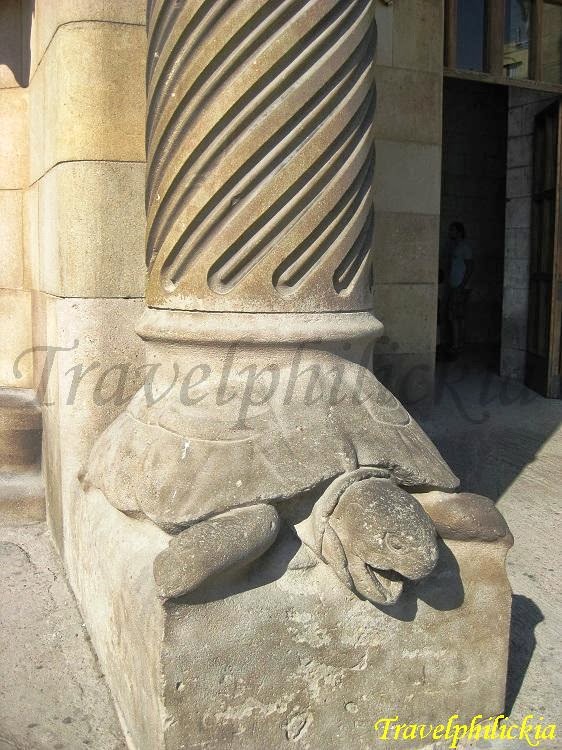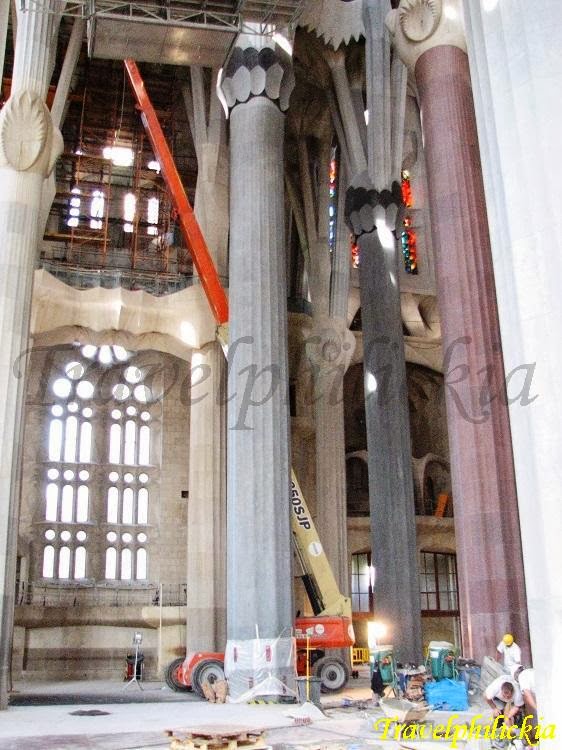We woke up early in the morning for the last 2 sights of our entire Barcelona trip. Took Metro from Liceu station to Sagrada Família station.
As we didn't take any breakfast, decided to have our breakfast at Farggi (left photo below) located near to the Sagrada Família entrance. Got myself a cup of Espresso and Sausage Sandwich (right photo below) that cost a total of EUR 3.30. The Espresso was rather bitter but good that the café provided sweets to neutralize the bitterness.


Sagrada Família
Basilica and Expiatory Church of the Holy Family, or Basílica i Temple Expiatori de la Sagrada Família in Catalan, is the formal name of the church. Better known as Sagrada Família, it is large Roman Catholic Church designed by Catalan Architect: Antoni Gaudí.
 |
Sagrada Família, togther with other Gaudí works, was listed as UNESCO World Heritage Site in 1984. |
Entrance Gate
- Long queue already formed at about 8.30 am outside the entrance gate (left photo below). Glad that we joined the queue early and we just waited briefly for about 30-mins before the attraction opened at 0900 hours. According to most tourist guides, visitors can wait for more than an hour prior to the admission. However we had to wait again for about another 10-mins for our audio guides (right photo below).


The schoolrooms
- This was the first building we visited after the entrance (photos below). The schoolrooms, or Las Escuelas in Catalan, were built for the children of the workmen and families of the neighborhood. The most distinctive feature of this building is its undulating roof and walls. The sinuous form provides the structure with a great resistance which allows water to pour on either side in an original and practical way.


Passion Façade
- In contrast to the highly decorated Nativity Façade, the Passion Façade is plain and simple, with ample bare stone, and carved with harsh straight lines to expresses the pain of Christ's death with austerity and harshness (left photo below). Facing west where sunsets, this façade recalls the cruelty of sacrifice through a series of sculptured groups which represent the last days of Christ. The Door of Gethsemane (right photo below) represents, by relief and verse, the garden where Jesus prayed before being seize whilst his disciples were sleeping.


The lower level of the façade depicts the events that happened the night before Christ's crucifixion. The closest group of sculptures is the Last Supper (left photo below), while the other group is the denial of Peter (right photo below).


After beaten, Jesus is presented to the people wearing a crown of thorns (left photo below). The middle level shows Jesus' second falter on the Calvary path (right photo below).


Besides the sculpture on the kiss of Judas (left photo below) is the cryptogram where it contains 16 numbers in which the sum, in different combinations, always adds up to 33 - the age when Christ died. The column of Christ's solitude during his flagellation has four division that symbolizes the four arms of the cross (right photo below).


On the left of Jesus are Mary Magdalene kneeling, and the Virgin Mary, who is consoled by John. Further back is Mary of Cleophas (left photo below). The cross is made with two iron bars (right photo below) where Jesus is crucified.


Church Museum
- We then walked into the museum to see the exhibits. Historical photographs and building sketches were on display along the walkways (photos below).


Miniatures relieving the details of the building (photos below) and fragments of the sculptures (bottom photos) were also on display.




Artist at work in the gypsum workshop making models (photos below).


Photographs taken in the last century illustrated the humble beginning of this magnificent church (photos below).




Among the many pictures in the museum, two of them caught my attention. The sketch (left photo below) allowed visitors to visualize the current completed structures, colored in brown, against the future constructions in black lines. While the other picture (right photo below) revealed the splendor of the fully completed church, making it the tallest church in the world by then.


The design concept behind the complex structures is explained through pictures and text (photos below).


Nativity Façade
- Dedicated to the birth of Jesus, the Nativity Façade (photos below) is richly decorated with scenes of reminiscent elements of life. The sculptures are ornately arranged and decorated with images from nature; each a symbol in their own manner.


The Coronation of Mary represents the moment in which the Virgin is crowned as reward for her self-sacrificing love for God (left photo below). Satisfying Hebrew law, Joseph and Mary present their child to the temple, where Jesus is blessed by the priest Simon (right photo below).


The Adoration of the Kings where Melchior, Caspar and Balthazar, known to be the Three Wise Men, offered their gifts in gold, frankincense and myrrh to Jesus (left photo below). The Adoration of the Shepherds where they were the first to see the star and worship the baby Jesus (right photo below).


With the bronze trumpets, the angels announced the birth of Jesus (photos below).


Other angel musicians joined the trumpeters using instruments like bassoon (left photo below) and harp (right photo below).


The Tree of Life is a pinnacle which represents the triumph of life and the legacy of Jesus. The letters "JHS" which refers to Jesus Christ, are on a cross, on whose sides are Greek letters alpha and omega (left photo below). The tree symbolizes eternal life for its resistant wood and its evergreen leaves (right photo below).


Temple Towers
- The exterior of the monuments holds an extraordinary symbolism which Gaudí knew how to give expression to. Standing at different heights from 100 to 118-meters, the bell towers represents each of Jesus' twelve apostles (photos below). On the top of the tower is a double-sided shield with a golden cross and on its sides is the apostle's initial who the tower is dedicated to.


On each of the tower has its respective sculpture, for example Thomas the Apostle (left photo below) and Saint James the Lesser (right photo below).


Apse Façade
- The apse exterior is a reflection of the great fascination that Gaudí held for nature. For instance, at the base of each two large columns lies a tortoise (left photo below) and a turtle (right photo below); in which one to represent the land and the other the sea, and each are symbols of time as something set in stone and unchangeable.


Gaudí preferred to use common animals that were traditionally associated with evil. These amphibians, reptiles and snails (photos below) on the walls are not allowed to enter the temple, and all with their head down to depict their fleeing from purity radiating from Mary's symbols.


Temple's Interior
- Finally we entered the temple interior. Construction workers could be seen busy with their work (photos below).


Gaudí used light to achieve artistic effects and accentuate the temple's mysticism. With beautiful colors and marked shapes, the stained glass is one of the highlights of the church (photos below).




The central nave vaults could reach forty-five meters while the side nave vaults reach thirty meters. Besides branching to support their load, their ever-changing surfaces are the result of the intersection of various geometric forms (photos below).


Admission to the temple cost EUR 11 per adult (left photo below), while the rental of each audio guide cost 3 EUR (right photo below).


Opening hours of the Basilica from 0900 hours till 1800 hours (Oct to Mar) or 0900 hours till 2000 hours (Apr to Sep), and special opening on 25th and 26th Dec and 1st till 6th Jan from 0900 hours till 1400 hours. Do note that no tickets will be sold after 15 minutes before closing time.
Gaudi Park
Park Güell or Gaudi Park is a garden complex with architectural elements situated on the hill of El Carmel in the Gràcia district. It was designed by the Catalan architect Antoni Gaudí and built in the years 1900 to 1914. It has an extension of 0.1718-km², which makes it one of the largest architectural works in south Europe.
 |
Together with the other works of Antoni Gaudí, the Park Güell is listed as UNESCO World Heritage site in 1984. |


The large cross at the Park's high-point (left photo below) offers the most complete view of Barcelona and the bay (right photo below).


The highlight of the park is the main terrace where it is surrounded by a long undulating bench in the form of a sea serpent where the curves form a number of enclaves (photos below).


Stretch of viaducts rise above the vaults which are formed by leaning columns (photos below). These arcaded ways adapt to the rough terrain by means of slanting columns that are decorated with stones from the same park.


A total of eighty-six Doric columns supported the market place. Circular and with a fluted surface, they are 6-meters high with a diameter of 120-meters (left photo below). The large rosettes on the market place ceiling, with a 3-meter diameter, represent the sun in the middle (right photo below).


The most iconic structure in the park is this mosaic salamander, popularly known as the dragon or el drac in Catalan, at the main entrance (left photo below). It is a prefabricated piece of hollow brick that, once put into position, was covered in ceramic work of vibrant color. In a medallion shape, this sculpture represents a serpent that appears below the Catalan flag (right photo below). The reptile could possibly be Nejustán, the bronze serpent that Moses put on his stuff to ward off poisonous creatures in the desert.


The park entrance separates the grey and mundane city from the ideal urbanization of bursting color and exotic forms in the park. Two lodges flanked the entrance gate, namely the Caretaker's lodge (left photo below) and Administration lodge (right photo below). Despite their whimsical appearance, these two buildings are strictly functional.


No entrance fee is required to enter this park.
We then exit the park and walked for about 10-mins towards the Lesseps station which is closer from the main entrance.
Lunch at La Rambla
After some wash-up in the hotel, we then checked out the room and had lunch in a fast-food restaurant. It wasn’t that difficult to order from the menu as most of the text was in English (left photo below). Ordered a 2-piece chicken meal that cost EUR 7.30, in which the fried chicken tasted the same back home in Singapore.


After which we took the Aerobús to the airport.
Reached Geneva Airport at 1840 hours. With this, we ended our short weekend trip to Barcelona.
 Posts RSS
Posts RSS


